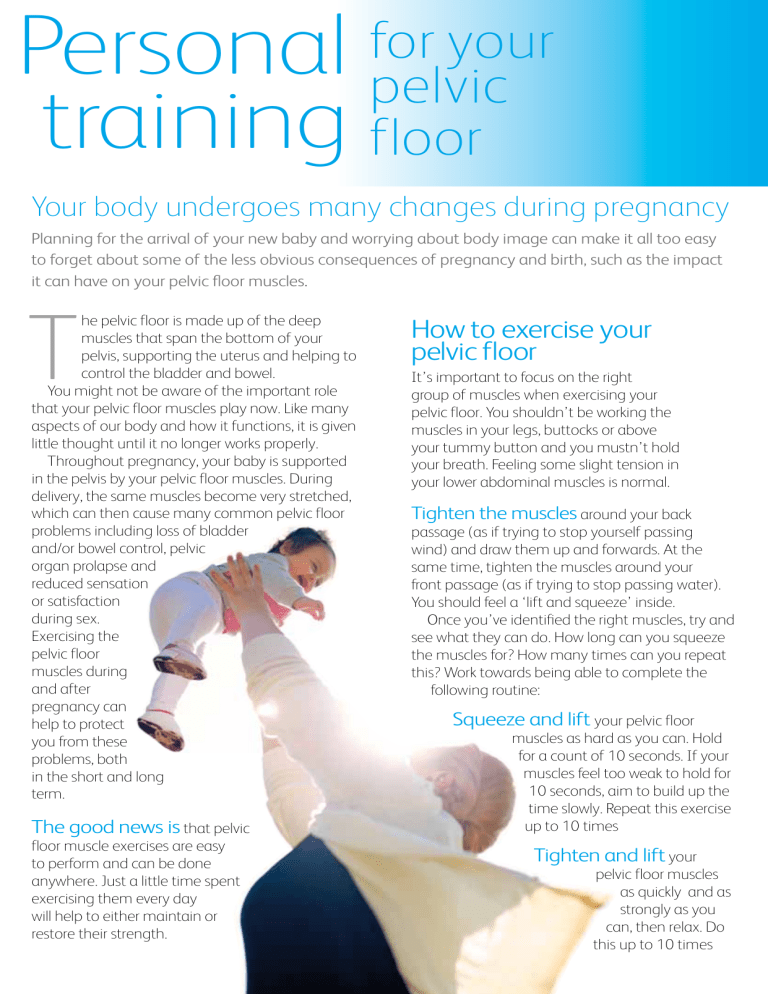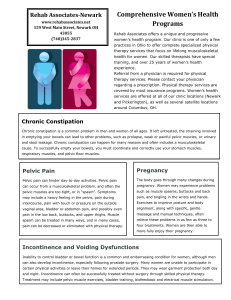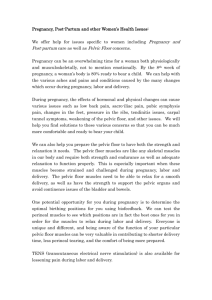Personal training for your pelvic

Personal training for your pelvic floor
Your body undergoes many changes during pregnancy
Planning for the arrival of your new baby and worrying about body image can make it all too easy to forget about some of the less obvious consequences of pregnancy and birth, such as the impact it can have on your pelvic floor muscles.
T he pelvic floor is made up of the deep muscles that span the bottom of your pelvis, supporting the uterus and helping to control the bladder and bowel.
You might not be aware of the important role that your pelvic floor muscles play now. Like many aspects of our body and how it functions, it is given little thought until it no longer works properly.
Throughout pregnancy, your baby is supported in the pelvis by your pelvic floor muscles. During delivery, the same muscles become very stretched, which can then cause many common pelvic floor problems including loss of bladder and/or bowel control, pelvic organ prolapse and reduced sensation or satisfaction during sex.
Exercising the pelvic floor muscles during and after pregnancy can help to protect you from these problems, both in the short and long term.
The good news is
that pelvic floor muscle exercises are easy to perform and can be done anywhere. Just a little time spent exercising them every day will help to either maintain or restore their strength.
How to exercise your pelvic floor
It’s important to focus on the right group of muscles when exercising your pelvic floor. You shouldn’t be working the muscles in your legs, buttocks or above your tummy button and you mustn’t hold your breath. Feeling some slight tension in your lower abdominal muscles is normal.
Tighten the muscles
around your back passage (as if trying to stop yourself passing wind) and draw them up and forwards. At the same time, tighten the muscles around your front passage (as if trying to stop passing water).
You should feel a ‘lift and squeeze’ inside.
Once you’ve identified the right muscles, try and see what they can do. How long can you squeeze the muscles for? How many times can you repeat this? Work towards being able to complete the following routine:
Squeeze and lift
your pelvic floor muscles as hard as you can. Hold for a count of 10 seconds. If your muscles feel too weak to hold for
10 seconds, aim to build up the time slowly. Repeat this exercise up to 10 times
Tighten and lift
your pelvic floor muscles as quickly and as strongly as you can, then relax. Do this up to 10 times
Aim to perform these
three times over the course of a day, every day. Each set of exercises takes about 2 ½ minutes
Try to squeeze and lift
your pelvic floor muscles each time you pick up anything heavy
(including babies, car seats) and before you cough, or sneeze. This helps your pelvic floor muscles to support the increasing downward pressure on your body.
Remembering to exercise
It’s important to begin these exercises during your pregnancy and to discuss any concerns you have with your midwife. You should continue this routine as soon as possible after the birth of your baby, even if you have had a caesarean delivery. It is safe to gently restart your exercises even if you are a bit sore, or have stitches. If you have had a urinary catheter, then wait until this is removed and you are passing water normally.
Initially you may find it difficult to feel your pelvic floor muscles working. It takes some weeks to build their strength back up. Take the exercises slowly at first but do persevere because you will soon regain awareness of the pelvic floor muscles contracting and relaxing.
Remembering to make time
for your exercises can be a challenge but they need to become part of your daily routine and you should prioritise time for them in the same way you do for brushing your teeth.
Find times that work for you, perhaps in the bath, when resting in bed, or whilst feeding or cuddling your baby.
Sticking with it
Like any exercise programme, don’t expect instant results. It will take weeks of regular exercise to improve your pelvic floor muscles and perhaps several months to regain their previous strength. If you do your exercises three times a day then you should notice a difference after about six weeks. And then you can drop to doing the exercises once a day. The reality is that you need to do these exercises, every day, for the rest of your life.
Further help
If you find the exercises described here difficult and they don’t seem to be working after six weeks, talk to your midwife or GP.
They may refer you to a women’s health physiotherapist for extra help.
Chartered women’s health physiotherapists, along with physiotherapists working in continence care, are experts in pelvic floor muscle exercise and training.
For further advice and information, contact:
•
Chartered Society of Physiotherapy (CSP)
www.csp.org.uk
•
Royal College of Midwives (RCM)
www.rcm.org.uk
CSP Headquarters
14 Bedford Row
London WC1R 4ED
Tel: 020 7306 6666
Fax: 020 7306 6611
Email: enquiries@csp.org.uk
Royal College of Midwives
15 Mansfield Street
London W1G 9NH
RCM Connect:
0300 303 0444





